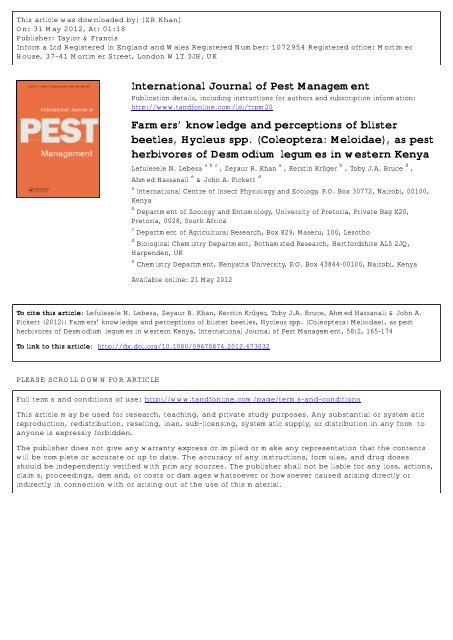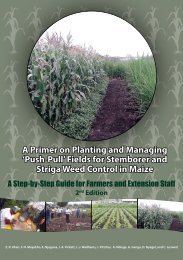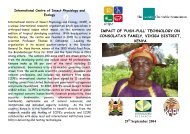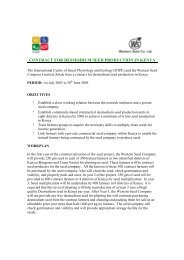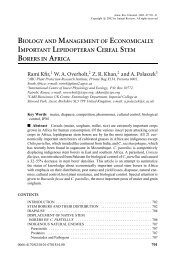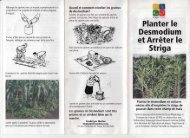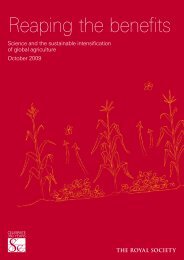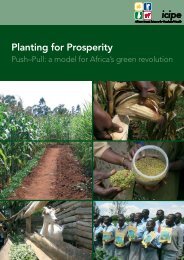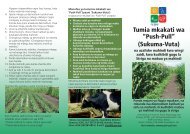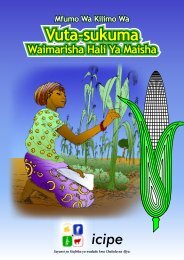Lebesa, L.N., Khan, Z.R., Kruger, K., Bruce, T.J.A ... - Push-Pull
Lebesa, L.N., Khan, Z.R., Kruger, K., Bruce, T.J.A ... - Push-Pull
Lebesa, L.N., Khan, Z.R., Kruger, K., Bruce, T.J.A ... - Push-Pull
You also want an ePaper? Increase the reach of your titles
YUMPU automatically turns print PDFs into web optimized ePapers that Google loves.
This article was downloaded by: [ZR <strong>Khan</strong>]<br />
On: 31 May 2012, At: 01:18<br />
Publisher: Taylor & Francis<br />
Informa Ltd Registered in England and Wales Registered Number: 1072954 Registered office: Mortimer<br />
House, 37-41 Mortimer Street, London W1T 3JH, UK<br />
International Journal of Pest Management<br />
Publication details, including instructions for authors and subscription information:<br />
http://www.tandfonline.com/loi/ttpm20<br />
Farmers’ knowledge and perceptions of blister<br />
beetles, Hycleus spp. (Coleoptera: Meloidae), as pest<br />
herbivores of Desmodium legumes in western Kenya<br />
Lefulesele N. <strong>Lebesa</strong> a b c , Zeyaur R. <strong>Khan</strong> a , Kerstin Krüger b , Toby J.A. <strong>Bruce</strong> d ,<br />
Ahmed Hassanali e & John A. Pickett d<br />
a International Centre of Insect Physiology and Ecology, P.O. Box 30772, Nairobi, 00100,<br />
Kenya<br />
b Department of Zoology and Entomology, University of Pretoria, Private Bag X20,<br />
Pretoria, 0028, South Africa<br />
c Department of Agricultural Research, Box 829, Maseru, 100, Lesotho<br />
d Biological Chemistry Department, Rothamsted Research, Hertfordshire AL5 2JQ,<br />
Harpenden, UK<br />
e Chemistry Department, Kenyatta University, P.O. Box 43844‐00100, Nairobi, Kenya<br />
Available online: 21 May 2012<br />
To cite this article: Lefulesele N. <strong>Lebesa</strong>, Zeyaur R. <strong>Khan</strong>, Kerstin Krüger, Toby J.A. <strong>Bruce</strong>, Ahmed Hassanali & John A.<br />
Pickett (2012): Farmers’ knowledge and perceptions of blister beetles, Hycleus spp. (Coleoptera: Meloidae), as pest<br />
herbivores of Desmodium legumes in western Kenya, International Journal of Pest Management, 58:2, 165-174<br />
To link to this article: http://dx.doi.org/10.1080/09670874.2012.673032<br />
PLEASE SCROLL DOWN FOR ARTICLE<br />
Full terms and conditions of use: http://www.tandfonline.com/page/terms-and-conditions<br />
This article may be used for research, teaching, and private study purposes. Any substantial or systematic<br />
reproduction, redistribution, reselling, loan, sub-licensing, systematic supply, or distribution in any form to<br />
anyone is expressly forbidden.<br />
The publisher does not give any warranty express or implied or make any representation that the contents<br />
will be complete or accurate or up to date. The accuracy of any instructions, formulae, and drug doses<br />
should be independently verified with primary sources. The publisher shall not be liable for any loss, actions,<br />
claims, proceedings, demand, or costs or damages whatsoever or howsoever caused arising directly or<br />
indirectly in connection with or arising out of the use of this material.
International Journal of Pest Management<br />
Vol. 58, No. 2, April–June 2012, 165–174<br />
Farmers’ knowledge and perceptions of blister beetles, Hycleus spp. (Coleoptera: Meloidae), as pest<br />
herbivores of Desmodium legumes in western Kenya<br />
Lefulesele N. <strong>Lebesa</strong> a,b,c *, Zeyaur R. <strong>Khan</strong> a , Kerstin Kru¨ger b , Toby J.A. <strong>Bruce</strong> d , Ahmed Hassanali e and<br />
John A. Pickett d<br />
a International Centre of Insect Physiology and Ecology, P.O. Box 30772, Nairobi 00100, Kenya; b Department of Zoology and<br />
Entomology, University of Pretoria, Private Bag X20, Pretoria, 0028, South Africa; c Department of Agricultural Research, Box 829,<br />
Maseru, 100, Lesotho; d Biological Chemistry Department, Rothamsted Research, Harpenden, Hertfordshire AL5 2JQ, UK;<br />
e Chemistry Department, Kenyatta University, P.O. Box 43844-00100, Nairobi, Kenya<br />
(Received 11 January 2011; final version received 18 October 2011)<br />
Downloaded by [ZR <strong>Khan</strong>] at 01:18 31 May 2012<br />
A survey was undertaken to determine the pest status of herbivorous blister beetles, Hycleus spp., in western Kenya<br />
where they attack crops such as Desmodium spp., other leguminous plants and sweetpotato. Desmodium spp. are<br />
important intercrops in the ‘push–pull’’ strategy adopted for Striga and stemborer control in maize and sorghum.<br />
Production of desmodium seed is adversely affected by blister beetles, which feed on the flowers and negatively affect<br />
seed setting. To assess farmers’ knowledge and perceptions of Hycleus spp. as pests, a questionnaire survey was<br />
conducted in three sites in Bungoma district, western Kenya, in 2007. The survey was followed by field sampling of<br />
Desmodium spp. and sweetpotato to compare the results with the responses received from farmers. Hycleus spp. were<br />
mentioned by 75% of the respondents as major pests of Desmodium spp. During field sampling Hycleus spp.<br />
comprised 70% of the insect pests collected. According to farmers, blister beetles were more abundant on<br />
desmodium than on sweetpotato. However, field sampling revealed that differences in beetle abundance on the two<br />
crops were not consistent across different sites, suggesting that these crops may function as alternative hosts. The<br />
study provides baseline information for the development of a management strategy for blister beetles.<br />
Keywords: Desmodium spp.; questionnaire; field survey; pest status; sweetpotato<br />
1. Introduction<br />
Desmodium spp. (Fabaceae), such as Desmodium<br />
uncinatum Jacq. DC., play an important role as<br />
intercrops for maize and sorghum in ‘‘push–pull’’<br />
crop protection strategies due to their repellent<br />
(‘‘push’’) properties against maize stemborers (Lepidoptera),<br />
and their ability to cause suicidal germination<br />
of dormant seeds of witchweed, Striga spp.<br />
(Scrophulariaceae), and so suppress population levels<br />
of that parasitic weed (<strong>Khan</strong> et al. 2000, 2002, 2006a,<br />
2006b, 2008a). The ‘‘push–pull’’ strategy was developed<br />
for small-scale farmers by ICIPE (International<br />
Centre of Insect Physiology and Ecology) and its two<br />
partners, KARI (Kenya Agricultural Research Institute,<br />
Kenya) and Rothamsted Research, UK (Pickett<br />
1998; Cook et al. 2007; <strong>Khan</strong> et al. 2008a). Apart from<br />
its role as an intercrop in the ‘‘push–pull’’ technology,<br />
Desmodium spp. (hereafter referred to as desmodium)<br />
are also nutritious fodder crops for livestock (PANE-<br />
SA/ARNAB 1990; Paterson et al. 1998; <strong>Khan</strong> et al.<br />
2006a). Thus, desmodium is valuable for small-scale<br />
farmers. The increased demand for desmodium seed<br />
associated with the widespread adoption of the ‘‘push–<br />
pull’’ technology prompted ICIPE and its partners to<br />
establish community-based desmodium seed production<br />
units in East Africa (<strong>Khan</strong> et al. 2008b).<br />
The main constraint upon the production of<br />
desmodium seed is infestation by blister beetles,<br />
notably Hycleus spp. (Coleoptera: Meloidae; formerly<br />
Coryna) (Pickett et al. 2010; <strong>Lebesa</strong> et al. 2011), which<br />
feed on flowers causing damage and preventing the<br />
development of seed. Apart from desmodium, blister<br />
beetles have been observed feeding on floral parts of<br />
other crops such as sweetpotato, cowpea and okra in<br />
several parts of western Kenya (L.N. <strong>Lebesa</strong>, unpublished<br />
observations). The available literature on<br />
meloids in Kenya, however, mainly documents Coryna<br />
and Mylabris as being associated with other leguminous<br />
crops (Abate and Ampofo 1996; Hillocks et al.<br />
2000). Mylabris spp. and Coryna spp. are reported to<br />
co-occur frequently on the same plant crop in various<br />
sub-Saharan countries (Abate and Ampofo 1996;<br />
Tanzubil and Yakubu 1997; Lale and Sastawa 2000).<br />
In West Africa, several species of blister beetle, for<br />
example Psalydolytta spp., Mylabris spp. and Hycleus<br />
spp. (formerly Coryna) (Bologna and Pinto 2002), have<br />
been observed feeding on pollen or flowers of various<br />
grain crops such as sorghum, pearl millet and cowpea,<br />
*Corresponding author. Email: lefulesele@yahoo.com<br />
ISSN 0967-0874 print/ISSN 1366-5863 online<br />
Ó 2012 Taylor & Francis<br />
http://dx.doi.org/10.1080/09670874.2012.673032<br />
http://www.tandfonline.com
Downloaded by [ZR <strong>Khan</strong>] at 01:18 31 May 2012<br />
166 L.N. <strong>Lebesa</strong> et al.<br />
which reduces grain yields (Gahukar 1991; Lale and<br />
Sastawa 2000).<br />
Adult blister beetles may range from 5 mm to<br />
40 mm in body length, depending on the species<br />
(Scholtz and Holm 1986). The adult female lays<br />
cylindrical eggs in batches in the soil. Upon hatching<br />
into active larvae called triungulins, the progeny search<br />
for grasshopper eggs for feeding (Hill 1975; Selander<br />
1986; Abate and Ampofo 1996; O¨ zbek and Szaloki<br />
1998). The larvae develop into later larval stages inside<br />
the grasshopper egg pod (Nikbakhtzadeh 2004).<br />
Damage to plants is inflicted by adult beetles only;<br />
these feed on both floral parts as well as on the<br />
developing seeds, thereby negatively affecting seed<br />
setting and, consequently, yields. Meloids are largely<br />
polyphagous, feeding on a wide range of host plants<br />
within families such as Fabaceae, Malvaceae,<br />
Convolvulaceae and Solanaceae (Selander 1986;<br />
Bologna and Pinto 2002; Zhu et al. 2005; <strong>Lebesa</strong><br />
et al. 2011).<br />
Although the presence of blister beetles in different<br />
crops is usually not considered to be a serious<br />
constraint (Hill 1975; Zhu et al. 2005), infestations of<br />
crops grown in small-holder plots may cause considerable<br />
damage because of the gregarious nature of adult<br />
blister beetles (Hall 1984; Nikbakhtzadeh 2004). Evans<br />
et al. (1989) reported that more than 80% of flowers<br />
and developing pods of a prairie legume, Baptisia<br />
australis (L.) R. Br. (Fabaceae) were damaged by the<br />
blister beetle Epicauta fabricii LeConte, thereby<br />
adversely affecting seed production. Blister beetles are<br />
similarly becoming a very important pest in East Africa<br />
because of increasing demand for desmodium seeds by<br />
small-holder farmers adopting the ‘‘push–pull’’ strategy<br />
for controlling stemborers and striga. As an<br />
introduced crop in eastern Africa (Agnew and Agnew<br />
1994; Cook et al. 2005), there is limited information on<br />
its pests, especially blister beetles, which represent a<br />
significant challenge to desmodium seed production<br />
and the ‘‘push–pull’’ farming system.<br />
We undertook a survey to provide baseline information<br />
required for the development of management<br />
strategies for blister beetles on desmodium. A questionnaire<br />
was provided to small-holder farmers to: (i)<br />
assess their knowledge and perception of the pest status<br />
of blister beetles (Hycleus spp.), (ii) document current<br />
control methods and their effectiveness, and (iii) record<br />
the farmers’ perceptions of the host range of the blister<br />
beetles. In addition, a field survey to assess the<br />
abundance of blister beetles on desmodium and<br />
alternative host plants was undertaken to compare<br />
the results with the responses of farmers.<br />
2. Material and methods<br />
2.1. Household survey<br />
A household survey was undertaken in the Bungoma<br />
district (0834 0 to 0839 0 S, 34830 0 to 34832 0 E) in the<br />
Western Province in Kenya in October and November<br />
2007 to identify potential crops infested by blister<br />
beetles; this was followed by a field survey. A questionnaire<br />
was developed and enumerators with knowledge<br />
of the local language were trained on how to interview<br />
farmers. Thereafter, enumerators undertook face-toface<br />
interviews in 92 farm households. Participating<br />
farmers were selected randomly within the three<br />
categories of farmers from three sub-locations in the<br />
Bungoma district. Of these, 44 were from Marakaru<br />
and Tutii and involved in producing desmodium seed,<br />
33 farmers from the same areas were practising the<br />
‘‘push–pull’’ technology, and 15 farmers from Kapchai<br />
were not involved in either the ‘‘push–pull’’ technology<br />
or desmodium seed production. The latter group of<br />
farmers was, however, planting sweetpotato (Ipomoea<br />
batatas (L.) Lam., Convolvulaceae), an alternative host<br />
of Hycleus spp. (Table 1). Care was taken to balance<br />
gender, where possible, to avoid a potential sex bias.<br />
The questionnaire was prepared to obtain information<br />
on: (i) demographic information on farmers,<br />
which included gender and the highest education level<br />
attained; (ii) farming practices, including farm sizes,<br />
type of crops planted, and mode of farming (mono- or<br />
mixed-cropping); and (iii) farmers’ perception of pest<br />
problems on desmodium and other crops (pest status,<br />
extent of damage caused by blister beetles, control<br />
methods used, if any) to compare this with previously<br />
received reports from desmodium seed producers.<br />
To improve accuracy of information gathering, the<br />
questionnaire included colour pictures of the different<br />
blister beetle species (Figure 1). If farmers were able to<br />
identify one or more species, they were asked to<br />
provide further information on the blister beetles. This<br />
included: (i) their abundance during different times of<br />
the day and seasons, (ii) the species that were<br />
dominant, (iii) the parts of the plant that were observed<br />
to be damaged, and (iv) estimated loss due to blister<br />
Table 1.<br />
Study sites, geographical zones and farmers’ sample distribution.<br />
No. of farmers per farm type<br />
Sub-location<br />
Elevation<br />
(m a.s.l.) Coordinates<br />
<strong>Push</strong>–pull<br />
technology<br />
Seed<br />
production<br />
No<br />
desmodium<br />
Total no.<br />
of farmers<br />
Marakaru 1430–1530 0838 0 –0840 0 N, 34831 0 –34832 0 E 13 18 – 31<br />
Tutii 1230–1540 0835 0 –0839 0 N, 34830 0 –34833 0 E 20 26 – 46<br />
Kapchai 1390–1490 0835 0 –0836 0 N, 34831 0 –34832 0 E – – 15 15
Downloaded by [ZR <strong>Khan</strong>] at 01:18 31 May 2012<br />
International Journal of Pest Management 167<br />
Figure 1. Hycleus spp. recorded on Desmodium spp. and sweetpotato in different parts of Kenya between 2006 and 2009. These<br />
sample pictures were shown to farmers in Bungoma to identify which of the beetles attacked their crops (identification of beetles<br />
by Marco Bologna, Roma TRE University).<br />
beetle attack compared to years when damage by<br />
beetles was minimized through pesticide application.<br />
Farmers’ responses were divided into ‘‘yes’’ or ‘‘no’’<br />
categories (e.g. recognition of blister beetles), or into<br />
three- to five-point codes representing a response to<br />
each question (e.g. pest recognized and mentioned by a<br />
farmer had five-point codes).<br />
2.2. Field sampling<br />
Although farmers mentioned desmodium, sweetpotato<br />
and beans (Phaseolus vulgaris (L.), Fabaceae) as the<br />
main host crops of Hycleus spp. in Bungoma, only<br />
desmodium and sweetpotato had reached flowering<br />
stages and therefore were available for sampling.<br />
Sampling for the presence of blister beetles and other<br />
pests was undertaken in the sub-locations of Marakaru,<br />
Tutii and East Bukusu (another desmodiumproducing<br />
area) in the Bungoma district, western<br />
Kenya. East Bukusu replaced Kapchai, because the<br />
latter had neither sweetpotato nor desmodium plants<br />
at the time of the survey.<br />
Sampling was done twice in the space of two weeks<br />
(week 43 in October and 46 in November 2007) to
Downloaded by [ZR <strong>Khan</strong>] at 01:18 31 May 2012<br />
168 L.N. <strong>Lebesa</strong> et al.<br />
capitalize on availability of flowers. During the first<br />
sampling, three fields of each crop were sampled except<br />
for Marakaru where only two sweetpotato fields were<br />
available. Desmodium, on the other hand, was<br />
sampled only from Tutii and Marakaru because in<br />
East Bukusu, desmodium plants had been slashed off<br />
and only sweetpotato could be sampled. Hycleus spp.<br />
have two peak activity periods which occur in the<br />
morning between 09:00h and 11:00h and in the<br />
afternoon between 15:00h and 17:00h (L. N. <strong>Lebesa</strong>,<br />
unpublished data). Accordingly, sampling of blister<br />
beetles on the two crops was undertaken during these<br />
peak activity periods. Separate records were kept for<br />
the morning and afternoon periods. During the second<br />
sampling period, two fields per crop (desmodium and<br />
sweetpotato) were sampled.<br />
During each survey, sampling was carried out in a<br />
standard area of 100 m 2 within each field because of<br />
variations in field size. Because desmodium and<br />
sweetpotato plants are creepers, it was difficult to<br />
distinguish between individual plants. Therefore,<br />
twenty 1 6 1 m sub-plots within a field were chosen<br />
at a spacing of 2 m and sampling followed a W-pattern<br />
across the field. Leaves and flowers present within the<br />
1 6 1 m sub-plots were visually inspected for the<br />
presence of beetles and other pests.<br />
Since blister beetles tend to drop to the ground and<br />
feign death when disturbed, aerial parts of plants were<br />
lifted to search the ground underneath for the beetles.<br />
Beetles were collected and kept in aerated containers<br />
that were labelled with the field number and location,<br />
host plant, date and time of sampling for inspection in<br />
the laboratory to separate species and sex.<br />
2.3. Statistical analysis<br />
Calculation of the percentage of farmers giving the<br />
same response to a question was based on the total<br />
number of farmers that responded to the question. If a<br />
farmer gave more than one answer to a question, each<br />
was included in the appropriate group of responses to<br />
the question. As a result, percentages for some<br />
questions exceeded 100% (Ebenebe et al. 2001; Tefera<br />
2004; Obopile et al. 2008). Chi-squared analyses of the<br />
relevant frequencies were analysed as 2 6 2 contingency<br />
tables to determine whether the beetle abundances<br />
were related to the two practices of growing<br />
desmodium (‘‘push–pull’’ technology or seed production)<br />
and to the number of years that a farmer had<br />
been involved with desmodium production.<br />
Gamma correlation was further used to determine<br />
correlations between years of experience of growing<br />
desmodium and the pest status of blister beetles<br />
(Healey 1990).<br />
Data from the field sampling were not normally<br />
distributed even after transformation, therefore nonparametric<br />
tests were employed for analyses. Kruskal–<br />
Wallis analysis of variance (ANOVA) was used to<br />
determine the significance of differences in the abundances<br />
of beetles between different fields, and within<br />
and between the host plants sampled in each location.<br />
Paired tests were used to test for any significant<br />
differences between the abundances of beetles on the<br />
two hosts at two sub-locations (Mann–Whitney U-test)<br />
and their abundances in the morning compared to the<br />
afternoon (Wilcoxon Matched Pairs test). Data were<br />
analysed with Statistica (Version 7.0, StatSoft, Inc.,<br />
1984–2004).<br />
3. Results<br />
3.1. Household surveys<br />
3.1.1. Demographic characteristics and production<br />
practices<br />
The overall male to female ratio for all interviewed<br />
farmers was approximately 1 : 1, with slightly more<br />
females (53%) than males (47%). The overall proportion<br />
of females and males interviewed was similar for<br />
desmodium farmers (49% males and 51% females),<br />
although at Kapchai (a non-desmodium growing<br />
location) more female (67%) than male (33%) farmers<br />
were interviewed. The majority of the interviewed<br />
farmers had formal education, 42% having attended<br />
primary and 50% having attended secondary school.<br />
Only 8% had no formal education (Table 2).<br />
Table 2. Summary of socio-economic characteristics and<br />
production practices of farmers interviewed.<br />
Variable<br />
Marakaru<br />
n (%)<br />
Tutii<br />
n (%)<br />
Kapchai<br />
n (%)<br />
Total<br />
responses<br />
n (%)<br />
Gender<br />
Female 16 (52) 22 (48) 10 (67) 48 (53)<br />
Male 15 (48) 24 (52) 5 (33) 44 (47)<br />
Education<br />
No formal education 5 (16) 1 (2) 1 (6) 7 (8)<br />
Primary (Std 1–8) 7 (23) 25 (54) 7 (47) 39 (42)<br />
Secondary (Form 1–4) 19 (61) 20 (44) 7 (47) 46 (50)<br />
No. of crops per field<br />
4–5 6 (19) 9 (19) 2 (13) 17 (18)<br />
6–7 16 (52) 27 (59) 11 (74) 54 (59)<br />
47 9 (29) 10 (22) 2 (13) 21 (23)<br />
Desmodium farm size (ha)<br />
*NA – – 15 (16) 15 (16)<br />
50.40 17 (55) 32 (70) – 49 (53)<br />
0.40–0.80 (1–2) 11 (35) 13 (28) – 25 (27)<br />
0.81–2.02 (2–5) 3 (10) 1 (2) – 4 (4)<br />
Years of experience with desmodium<br />
1 2 (7) 3 (7) – 5 (7)<br />
2 12 (39) 12 (26) – 24 (31)<br />
3 9 (29) 14 (29) – 23 (30)<br />
43 8 (26) 17 (37) – 25 (32)<br />
*Refers to those farmers that were not growing desmodium.
Downloaded by [ZR <strong>Khan</strong>] at 01:18 31 May 2012<br />
Farms were characterized by small-holdings, ranging<br />
from less than 0.4 ha to approximately 2 ha per<br />
farm. On average, farmers’ plots were 0.4–0.8 ha per<br />
crop, including desmodium. The majority of the<br />
farmers (80%) grew five or more crops, most of which<br />
were intercropped (Table 2). The only two crops that<br />
were almost exclusively monocropped were sweetpotato<br />
(99%) and cowpea (92%). Maize and beans were the<br />
most important crops, grown by 100% and 98% of<br />
farmers, respectively. Desmodium was grown by 84%<br />
of farmers who either practised the ‘‘push–pull’’<br />
technology (39%) or were involved in seed multiplication<br />
(52%), while 9% were involved in both<br />
practices. Other crops grown included cassava<br />
(Manihot esculenta Crantz, Euphorbiaceae), bananas<br />
(Musa acuminata Colla, Musaceae), coffee (Coffea<br />
arabica L., Rubiaceae), groundnuts (Apios americana<br />
Medik., Fabaceae) and Napier grass (Pennisetum<br />
purpureum Schumach, Poaceae).<br />
The majority of farmers (62%) growing desmodium<br />
had been exposed to the crop for 3 years or more.<br />
Farmers with three of more years of experience tended<br />
to be seed-bulking farmers (39%). Other than for<br />
‘‘push–pull’’ and seed bulking, a small percentage of<br />
farmers (3%) grew desmodium for fodder production.<br />
Two desmodium species, silverleaf (Desmodium uncinatum)<br />
and greenleaf (D. intortum), were almost<br />
equally planted by farmers. Forty-seven per cent and<br />
51% of farmers mentioned D. uncinatum and<br />
D. intortum, respectively, while 2% were growing both.<br />
3.1.2. Farmers’ perception of pest incidence on different<br />
crops<br />
The pests mentioned by farmers for crops other than<br />
desmodium were stemborers (Lepidoptera); African<br />
bollworm, Helicoverpa armigera (Lepidoptera); aphids<br />
International Journal of Pest Management 169<br />
(Hemiptera: Aphididae); blister beetles, Hycleus spp.;<br />
sweetpotato weevils (Coleoptera: Curculionidae) and<br />
mole-rats (Bathyergidae), depending on the crop. For<br />
desmodium, only two pests, namely Hycleus spp. and<br />
H. armigera, were mentioned, of which the latter was<br />
not considered a serious pest of desmodium and was<br />
mentioned by less than 10% of farmers who grew<br />
desmodium (Figure 2).<br />
3.1.3. Knowledge of blister beetles, their host plants<br />
and damage caused<br />
Of the 92 farmers interviewed, the highest number of<br />
them reported blister beetles as pests of desmodium<br />
(63%) and beans (58%), followed by sweetpotato<br />
(51%). Only a few farmers mentioned blister beetles as<br />
pests of maize (14%) and cowpea (3%) (Figure 2).<br />
Seventeen per cent of the farmers believed that<br />
Desmodium spp. were free of pests. Farmers reported<br />
damage by blister beetles on flowers, seeds, leaves, and<br />
stems of crops attacked. For all crops, farmers<br />
reported the highest damage on flowers of beans<br />
(73%), desmodium (60%), sweetpotato (92%), and<br />
cowpea (100%), as well as pollen feeding on maize<br />
tassels (53%). For desmodium, damage to seed pods<br />
was considered most common after damage to flowers<br />
and was mentioned by 45% of desmodium-growing<br />
farmers. Damage to leaves and stems was mentioned<br />
by 14% and 3% of the desmodium farmers,<br />
respectively.<br />
When the pictures of different species of blister<br />
beetle were presented to farmers, 86 of them (93%)<br />
were able to identify the insects they were familiar with.<br />
The three species that were recognized were Hycleus<br />
apicicornis (72%), H. dubiosus Marseul (43%) and H.<br />
sjostedti Borchmann (40%). Farmers mentioned that<br />
all three species were observed feeding on desmodium,<br />
Figure 2.<br />
Percentage of respondent farmers that mentioned various pests that attack different crops in Bungoma.
Downloaded by [ZR <strong>Khan</strong>] at 01:18 31 May 2012<br />
170 L.N. <strong>Lebesa</strong> et al.<br />
maize, sweetpotato and beans, while on cowpea,<br />
farmers noted only H. apicicornis (Figure 3).<br />
Farmers were able to specify the time of peak<br />
activity of the blister beetles during the day and<br />
different seasons of the year. Seventy-two per cent of<br />
farmers mentioned the long rainy season (May–July) as<br />
the period when blister beetles were most abundant.<br />
Sixty-seven per cent and 79% of the farmers mentioned<br />
06:00–08:00h and 17:00–19:00h, respectively, as<br />
the hours at which activity of beetles peaked during<br />
the day.<br />
The incidence of blister beetles reported by farmers<br />
at the two locations was compared. The percentage of<br />
farmers who mentioned the presence of blister beetles<br />
on Desmodium spp. was higher in Tutii (82%) than in<br />
Marakaru (62%); however, differences in the number<br />
of farmers reporting blister beetles on Desmodium spp.<br />
in the two sub-locations were not significant (w 2 ¼ 3.42,<br />
df ¼ 1, P ¼ 0.064). There was a significant positive<br />
correlation between the experience farmers had in<br />
growing desmodium and the reported pest status of<br />
blister beetles on desmodium (g ¼ 70.35, n ¼ 77,<br />
P ¼ 0.015).<br />
3.1.4. Current control methods used against<br />
blister beetles<br />
Although blister beetles were recorded by the majority<br />
of farmers as a pest on the three major crops (beans,<br />
desmodium, and sweetpotato), only a few farmers were<br />
using control measures against the beetles. For<br />
desmodium, 33% of farmers were using some control<br />
measures, while for all other crops this was below 10%.<br />
The three control measures mentioned were chemical<br />
pesticides, physical methods (hand- picking of beetles<br />
and crushing) and application of ash. Of these,<br />
application of chemical pesticides was the most<br />
common, mentioned by 75% of farmers who were<br />
applying some form of control. Reasons given by<br />
farmers who did not employ any form of control<br />
measures against blister beetles included lack of<br />
knowledge on what to use (72%), unaffordable cost<br />
of pesticides (21%) and low pest damage (5%).<br />
Although the majority of farmers with blister beetle<br />
problems (82%) were not using any form of control,<br />
they rated it as a serious pest on both desmodium and<br />
beans. The severity of blister beetle damage on beans<br />
was said to be higher in mixed cropping systems (81%)<br />
than in bean mono-crops (15%). However, for<br />
desmodium the opposite was considered to be true,<br />
with more blister beetle damage reported by farmers<br />
producing desmodium seed (62%) than by those<br />
practising ‘‘push–pull’’ technology (29%); significantly<br />
more seed-producing than ‘‘push–pull’’ farmers reported<br />
blister beetle damage (w 2 ¼ 6.24, df ¼ 1,<br />
P ¼ 0.012). A small percentage of both groups (9%)<br />
reported no difference.<br />
Of the 58 farmers growing desmodium and who<br />
mentioned blister beetles as pests, 49 were able to<br />
estimate the amount of seed considered to be lost as a<br />
result of attack by these beetles. Damage estimates<br />
ranged from less than 2.5 kg per hectare to more than<br />
11 kg per hectare which is approximately 2–8% of<br />
their seed yield (130 kg/ha). The majority of farmers<br />
(47%) estimated the loss at less than 2.5 kg per hectare.<br />
Nineteen farmers (32%) estimated yield losses ranging<br />
Figure 3.<br />
Percentage of respondent farmers who identified three Hycleus spp. attacking various crops, with the aid of pictures.
International Journal of Pest Management 171<br />
Downloaded by [ZR <strong>Khan</strong>] at 01:18 31 May 2012<br />
between 2.5 kg and 11 kg per hectare, while only three<br />
farmers gave estimated losses of more than 11 kg per<br />
hectare.<br />
3.2. Field sampling<br />
3.2.1. Observed pests<br />
Two blister beetle species were recorded during the<br />
field sampling: Hycleus apicicornis and H. dubiosus.<br />
The former was the more abundant species (Table 3).<br />
Another pest recorded in this study was the African<br />
bollworm, Helicoverpa armigera. It was found on both<br />
desmodium and sweetpotato, although it was present<br />
in very low numbers (510 larvae in each sample site)<br />
(Table 3). Other insects collected included the common<br />
stink bug, Nezara viridula L. (Heteroptera: Pentatomidae)<br />
and other coleopteran pests such as Cylas spp.<br />
(Coleoptera: Curculionidae) on sweetpotato and the<br />
black maize beetle, Heteronychus arator Fabricius<br />
(Coleoptera: Scarabaeidae) on desmodium. Due to<br />
the low abundance of H. dubiosus, only H. apicicornis<br />
was selected for comparison among hosts and sampling<br />
locations. The abundance of H. apicicornis did not<br />
differ between morning and afternoon hours<br />
(Marakaru: Wilcoxon Matched Pairs test; Z ¼ 1.33,<br />
df ¼ 55, P ¼ 0.18; East Bukusu: Wilcoxon Matched<br />
Pairs test; Z ¼ 0.55, df ¼ 37, P ¼ 0.58), except in the<br />
Tutii sub-location where significantly more beetles<br />
were recorded in the morning (Wilcoxon Matched<br />
Pairs test; Z ¼ 3.93, df ¼ 85, P 5 0.0001).<br />
No sampling of desmodium was undertaken in East<br />
Bukusu because all plots had been slashed off at the<br />
time when farmers were visited. There were no significant<br />
differences (Kruskal–Wallis test; H 2,24 ¼ 0.775,<br />
P ¼ 0.679) in the abundances of beetles on sweetpotato<br />
across all sampled sites. A comparison of the<br />
abundances of beetles between the two crops was<br />
made for the Marakaru and Tutii sub-locations. In<br />
Marakaru, significantly more H. apicicornis adults<br />
were recorded on desmodium than on sweetpotato<br />
(Mann-Whitney U-test; Z adj . ¼ 3.095, df ¼ 178,<br />
P ¼ 0.002). However, in Tutii, there were significantly<br />
more of these beetles on sweetpotato than on<br />
desmodium (Mann–Whitney U-test; Z adj . ¼ 72.080,<br />
df ¼ 198, P ¼ 0.038).<br />
4. Discussion<br />
Information from the farmers was unlikely to be biased<br />
by gender because a balanced sample was taken.<br />
Likewise, the majority of farmers had attended school;<br />
therefore, opinions regarding knowledge of different<br />
pests were not likely to be influenced by different levels<br />
of education between different locations. Although<br />
farmers were producing all their crops on very small<br />
areas of less than one hectare, most farmers were<br />
growing six or more crops, most of which were<br />
Table 3. Mean count (+SD) of insect pests per quadrant on Desmodium spp. and sweetpotato fields in each of the three sublocations<br />
in Bungoma.<br />
Time of occurrence<br />
Sub-locations Host plants/insect pests 09h00–11h00 15h00–17h00 Mean total catches<br />
Marakaru<br />
Tutii<br />
East Bukusu<br />
Desmodium spp.<br />
Hycleus apicicornis 0.51 + 0.078 0.36 + 0.069 0.87 + 0.109<br />
Hy. dubiosus 0.00 + 0.000 0.01 + 0.010 0.01 + 0.010<br />
Helicoverpa armigera 0.01 + 0.010 0.01 + 0.010 0.02 + 0.014<br />
Nezara viridula 0.08 + 0.027 0.15 + 0.048 0.23 + 0.055<br />
Sweetpotato<br />
Hycleus apicicornis 0.22 + 0.067 0.21 + 0.055 0.44 + 0.096<br />
Hy. dubiosus 0.00 + 0.000 0.00 + 0.000 0.00 + 0.000<br />
Helicoverpa armigera 0.01 + 0.013 0.04 + 0.021 0.05 + 0.025<br />
Nezara viridula 0.08 + 0.043 0.00 + 0.000 0.08 + 0.043<br />
Desmodium spp.<br />
Hycleus apicicornis 0.28 + 0.060 0.27 + 0.053 0.55 + 0.077<br />
Hy. dubiosus 0.00 + 0.000 0.10 + 0.041 0.10 + 0.041<br />
Helicoverpa armigera 0.00 + 0.000 0.00 + 0.000 0.00 + 0.000<br />
Nezara viridula 0.55 + 0.007 0.38 + 0.087 0.93 + 0.151<br />
Sweetpotato<br />
Hycleus apicicornis 0.71 + 0.091 0.12 + 0.046 0.83 + 0.095<br />
Hy. dubiosus 0.12 + 0.046 0.00 + 0.000 0.12 + 0.046<br />
Helicoverpa armigera 0.01 + 0.010 0.00 + 0.000 0.01 + 0.010<br />
Nezara viridula 0.05 + 0.022 0.20 + 0.064 0.25 + 0.069<br />
Sweetpotato<br />
Hycleus apicicornis 0.39 + 0.071 0.44 + 0.070 0.83 + 0.106<br />
Hy. dubiosus 0.02 + 0.014 0.02 + 0.014 0.04 + 0.020<br />
Helicoverpa armigera 0.00 + 0.000 0.02 + 0.014 0.02 + 0.014<br />
Nezara viridula 0.04 + 0.020 0.01 + 0.010 0.05 + 0.022
Downloaded by [ZR <strong>Khan</strong>] at 01:18 31 May 2012<br />
172 L.N. <strong>Lebesa</strong> et al.<br />
intercropped. This practice was useful for assessing the<br />
occurrence of blister beetles, because farmers’ responses<br />
to the questionnaire were not based only on<br />
their desmodium crop.<br />
Responses to the questionnaire revealed that farmers<br />
were generally aware of the blister beetles, even<br />
before pictures were shown to them. This was the case<br />
for both desmodium and non-desmodium growing<br />
farmers and was confirmed by correct identification by<br />
the farmers of the plant parts that are damaged by<br />
blister beetles on different host plants. Flowers were<br />
mentioned as the most severely damaged plant organs,<br />
followed by seed. Blister beetle damage of developing<br />
seeds has been observed on desmodium in this study<br />
(L.N. <strong>Lebesa</strong>, personal observation). Damage on seeds<br />
by blister beetles has also been documented on other<br />
crops such as pearl millet (Zethner and Laurense 1988;<br />
Lale and Sastawa 2000) and a prairie legume (Evans<br />
et al. 1989).<br />
In addition to desmodium, blister beetles were also<br />
mentioned by the majority of farmers growing beans<br />
and sweetpotato, but by fewer farmers growing maize<br />
and cowpea. Cowpea was cultivated by fewer farmers<br />
making it less available as a host. However, a multiple<br />
choice feeding study in the laboratory confirmed that<br />
cowpea was the least preferred crop when compared to<br />
desmodium, sweetpotato, okra and beans (L.N.<br />
<strong>Lebesa</strong>, unpublished data). On maize, H. apicicornis<br />
has been observed to feed on pollen only (L.N. <strong>Lebesa</strong><br />
personal observation), hence could not have had a<br />
serious impact on maize yields and may account for the<br />
small number of farmers who noticed its presence on<br />
plants. However, in some crops, feeding on pollen by<br />
blister beetles may affect the number of grains and<br />
thereby reduce yields as was observed with pearl millet<br />
in West Africa (Gahukar 1984; Lale and Sastawa<br />
2000). Other than blister beetles, the African bollworm,<br />
Helicoverpa armigera was also mentioned by a few<br />
farmers as occurring on desmodium. This observation<br />
was supported by field sampling where the pest was<br />
found in very low numbers (510 larvae at each site),<br />
although H. armigera can be a problem for desmodium<br />
seed production (Boonman 1993).<br />
Although blister beetles were mentioned as pests by<br />
most respondents, few farmers were using any control<br />
measures. This could be attributed to a number of<br />
factors, some of which were highlighted in the interviews.<br />
These included lack of knowledge of effective<br />
control methods and non-availability and/or high cost<br />
of chemical pesticides, which have also been mentioned<br />
previously (Wightman and Wightman 1994; Mendesil<br />
et al. 2007). The practice of collecting beetles and<br />
crushing them, mentioned by a few farmers, may be<br />
harmful since farmers handle the beetles with bare<br />
hands. Blister beetles produce cantharidin (McCormick<br />
and Carrel 1987; Nikbakhtzadeh and Tirgari<br />
2002), a toxic terpenoid responsible for blistering if it<br />
comes into contact with skin (Carrel and Eisner 1974;<br />
McCormick and Carrel 1987). Levels of cantharidin in<br />
Hycleus spp. have been found to vary from negligible<br />
concentrations to high levels (Mebs et al. 2009).<br />
Although in this particular study, farmers did not<br />
complain about blistering, suggesting that levels may<br />
be low, there may be need for caution in this regard in<br />
the longer term.<br />
Farmers rated blister beetle damage as more serious<br />
on the seed bulking plots (desmodium monocrops)<br />
than on the ‘‘push–pull’’ stands (desmodium intercropped<br />
with maize). This is most likely due to less<br />
efficient location of desmodium (the preferred host) by<br />
the pest in a ‘‘push–pull’’ system. It is also possible that<br />
the impact on desmodium is lower in the mixed stands<br />
because beetles alternate between the two hosts to<br />
obtain different food resources to balance nutritional<br />
requirements (Bernays and Minkenberg 1997; Marques<br />
et al. 2000; Cook et al. 2004; Miura and Ohsaki 2004).<br />
Although the field survey to determine the abundance<br />
of blister beetles on different crop hosts was<br />
carried out during the short rainy season only, which is<br />
characterized by low populations of blister beetles, the<br />
outcome largely supported the perceptions of farmers.<br />
According to the farmers, the abundance of blister<br />
beetles on desmodium is slightly higher than on<br />
sweetpotato. However, this was not the case in either<br />
site sampled. On the other hand, follow-up collections<br />
of H. apicicornis on both crops at full flowering stage<br />
were almost the same on the two crops (L.N. <strong>Lebesa</strong>,<br />
personal observation). However, the blister beetle<br />
Hycleus dubiosus and the bollworm Helicoverpa<br />
armigera were more abundant on sweetpotato than<br />
on desmodium. Moreover, although the abundance of<br />
blister beetles on desmodium was higher at the<br />
Marakaru than the Tutii sub-location, where blister<br />
beetles were more abundant on sweetpotato than on<br />
desmodium, an overall comparison shows that occurrence<br />
of beetles was similar on the two crops. Thus,<br />
sweetpotato seems to be a good alternative host for this<br />
pest, and it would be interesting to explore the effect of<br />
intercropping sweetpotato with desmodium in seed<br />
production systems as a tactic in the management of<br />
blister beetles.<br />
In conclusion, the results of this survey show that<br />
the famers in the study area are cognizant of the blister<br />
beetles, especially Hycleus apicicornis, as a pest of<br />
desmodium. Their perceptions have been confirmed by<br />
field surveys. If not controlled, blister beetles have the<br />
potential to reduce the yield of desmodium seed. This<br />
in turn may negatively affect the success of the ‘‘push–<br />
pull’’ system of crop protection which requires<br />
desmodium as a companion plant to suppress Striga<br />
(Cook et al. 2007).<br />
Acknowledgements<br />
Research funds for this study were provided by Gatsby<br />
Charitable Foundation (UK) and the Kilimo Trust (East<br />
Africa). DAAD, the German Academic Exchange Service,
Downloaded by [ZR <strong>Khan</strong>] at 01:18 31 May 2012<br />
provided a grant to cover living expenses in Kenya for the<br />
first author. The University of Pretoria and the Lesotho<br />
Government are also acknowledged for providing both<br />
financial and logistical support in South Africa. We would<br />
like to express our gratitude to the following persons:<br />
Prof. Marco Bologna, Roma TRE University who identified<br />
the blister beetles free of charge; Mr J. Pitchaar and<br />
Dr A. Amudavi for commenting on the design of the<br />
questionnaires; Dr E.M. Njuguna, and anonymous referees<br />
for critical evaluation of the manuscript; Dr C. Midega for<br />
his comments on an earlier version of this work; the icipe field<br />
staff based in Bungoma and Kitale, specifically Aloice Ndiege<br />
and Phillip Akelo, who provided logistical support.<br />
References<br />
Agnew ADQ, Agnew S. 1994. Upland Kenya wild flowers – a<br />
flora of the ferns and herbaceous flowering plants of<br />
upland Kenya. 2nd edition. Nairobi: East Africa Natural<br />
History Society.<br />
Abate T, Ampofo JKO. 1996. Insect pests of beans in Africa:<br />
their ecology and management. Annu Rev Entomol.<br />
41:45–73.<br />
Bernays EA, Minkenberg OPJM. 1997. Insect herbivores:<br />
different reasons for being a generalist. Ecology. 78:1157–<br />
1169.<br />
Bologna MA, Pinto JD. 2002. The Old World genera of<br />
Meloidae (Coleoptera): a key and synopsis. J Nat Hist.<br />
36:2013–2102.<br />
Boonman JG. 1993. East Africa’s grasses and fodders: their<br />
ecology and husbandry. Chapter 10: Legumes in sown<br />
and grazed pastures. Dordrecht: Kluwer Academic<br />
Publishers. p. 190–206.<br />
Carrel JE, Eisner T. 1974. Cantharidin: potent feeding deterrent<br />
to insects. Science. 183:755–757.<br />
Cook BG, Pengelly BC, Brown SD, Donnelly JL, Eagles DA,<br />
Franco MA, Hanson J, Mullen BF, Partridge IJ, Peters<br />
M, Schultze-Kraft R. 2005. Tropical Forages: an interactive<br />
selection tool [CD-ROM]. Brisbane (Australia):<br />
CSIRO, DPI&F (Qld), CIAT and ILRI.<br />
Cook SM, <strong>Khan</strong> ZR, Pickett JA. 2007. The use of push–pull<br />
strategies in integrated pest management. Annu Rev<br />
Entomol. 52:375–400.<br />
Cook SM, Murray DA, Williams IH. 2004. Do pollen beetles<br />
need pollen The effect of pollen on oviposition, survival,<br />
and development of a flower-feeding herbivore. Ecol<br />
Entomol. 29:164–173.<br />
Ebenebe AA, Van den Berg J, Van der Linde TC. 2001. Farm<br />
management practices and farmers’ perceptions of stalkborers<br />
of maize and sorghum in Lesotho. Int J Pest<br />
Manage. 47:41–48.<br />
Evans EW, Smith CC, Gendron RP. 1989. Timing of<br />
reproduction in a prairie legume: seasonal impacts of<br />
insects consuming flowers and seeds. Oecologia. 78:220–<br />
230.<br />
Gahukar RT. 1984. Insect pests of pearl millet in West<br />
Africa: a review. Trop Pest Manage. 30:142–147.<br />
Gahukar RT. 1991. Pest status and control of blister beetles<br />
in West Africa. Trop Pest Manage. 37:415–420.<br />
Hall MJR. 1984. Trap-oriented behaviour of red-banded<br />
blister beetles, Mylabris designata var. hacolyssa Rochebrune<br />
(Coleoptera: Meloidae), in the Sudan. Bull Entomol<br />
Res. 74:103–112.<br />
Healey JF. 1990. Statistics: A tool for social research. 2nd<br />
edition. Belmont (CA): Wadsworth Publishing.<br />
Hill D.S. 1975. Agricultural insect pests of the tropics and<br />
their control. 1st edition. London: Cambridge University<br />
Press.<br />
International Journal of Pest Management 173<br />
Hillocks RJ, Minja E, Mwaga A, Nahdy MS, Subrahmanyam<br />
P. 2000. Diseases and pests of pigeonpea in eastern<br />
Africa: a review. Int J Pest Manage. 46:7–18.<br />
<strong>Khan</strong> ZR, Amudavi DM, Midega CAO, Wanyama JM,<br />
Pickett JA. 2008b. Farmers’ perceptions of a ‘‘push–pull’’<br />
technology for control of cereal stemborers and Striga<br />
weed in western Kenya. Crop Prot. 27:976–987.<br />
<strong>Khan</strong> ZR, Hassanali A, Overholt W, Khamis TM, Hooper<br />
AM, Pickett JA, Wadhams LJ, Woodcock CM. 2002.<br />
Control of witchweed Striga hermonthica by intercropping<br />
with Desmodium spp., and the mechanism defined as<br />
allelopathic. J Chem Ecol. 28:1871–1885.<br />
<strong>Khan</strong> ZR, Midega CAO, Amudavi DM, Hassanali A, Pickett<br />
JA. 2008a. On-farm evaluation of the ‘‘push–pull’’<br />
technology for the control of stemborers and striga<br />
weed on maize in Western Kenya. Field Crops Res.<br />
106:224–233.<br />
<strong>Khan</strong> ZR, Midega CAO, Hassanali A, Pickett JA, Wadhams<br />
LJ, Wanjoya A. 2006b. Management of witchweed, Striga<br />
hermonthica, and stemborers in sorghum, Sorghum<br />
bicolor, through intercropping with greenleaf desmodium,<br />
Desmodium intortum. Int J Pest Manage. 52:297–302.<br />
<strong>Khan</strong> ZR, Pickett JA, Van den Berg J, Wadhams LJ,<br />
Woodcock CM. 2000. Exploiting chemical ecology and<br />
species diversity: stem borer and striga control for maize<br />
and sorghum in Africa. Pest Manage Sci. 56:957–962.<br />
<strong>Khan</strong> ZR, Pickett JA, Wadhams LJ, Hassanali A, Midega<br />
CAO. 2006a. Combined control of Striga hermonthica<br />
and stemborers by maize–Desmodium spp. intercrops.<br />
Crop Prot. 25:989–995.<br />
Lale NES, Sastawa BM. 2000. Evaluation of host plant<br />
resistance, sowing date modification and intercropping<br />
as methods for the control of Mylabris and Coryna<br />
species (Coleoptera: Meloidae) infesting pearl millet<br />
in the Nigerian Sudan savanna. J Arid Environ.<br />
46:263–280.<br />
<strong>Lebesa</strong> LN, <strong>Khan</strong> ZR, Hassanali A, Pickett JA, <strong>Bruce</strong> TJA,<br />
Skellern M, Kru¨ger K. 2011. Responses of the blister<br />
beetle Hycleus apicicornis to visual stimuli. Physiol<br />
Entomol. 36:220–229.<br />
Marques ESA, Price PW, Cobb NS. 2000. Resource<br />
abundance and insect herbivore diversity on woody<br />
Fabaceous desert plants. Environ Entomol. 29:696–703.<br />
McCormick JP, Carrel JE. 1987. Cantharidin biosynthesis<br />
and function in meloid beetles. In: Prestwitch GD,<br />
Blomquist GJ, editors. Pheromone biochemistry. Orlando:<br />
Academic Press. p. 307–350.<br />
Mebs D, Pogoda W, Schneider M, Kauert G. 2009.<br />
Cantharidin and demethylcantharidin (palasonin) content<br />
of blister beetles (Coleoptera: Meloidae) from<br />
southern Africa. Toxicon. 53:466–468.<br />
Mendesil E, Abdeta C, Tesfaye A, Shumeta Z, Jifar H. 2007.<br />
Farmers’ perceptions and management practices of insect<br />
pests on stored sorghum in southwestern Ethiopia. Crop<br />
Prot. 26:1817–1825.<br />
Miura K, Ohsaki N. 2004. Diet mixing and its effect on<br />
polyphagous grasshopper nymphs. Ecol Res. 19:269–274.<br />
Nikbakhtzadeh MR. 2004. Transfer and distribution of<br />
cantharidin within selected members of blister beetles<br />
(Coleoptera: Meloidae) and its probable importance in<br />
sexual behaviour. PhD dissertation. Universita¨t Bayreuth,<br />
Germany.<br />
Nikbakhtzadeh MR, Tirgari S. 2002. Cantharidin component<br />
of Iranian blister beetles (Col: Meloidae) and their<br />
differences between Iranian and exotic species. Iranian J<br />
Publ Health. 31:113–117.<br />
Obopile M, Munthali DC, Matilo B. 2008. Farmers’ knowledge,<br />
perceptions and management of vegetable pests and<br />
diseases in Botswana. Crop Prot. 27:1220–1224.
Downloaded by [ZR <strong>Khan</strong>] at 01:18 31 May 2012<br />
174 L.N. <strong>Lebesa</strong> et al.<br />
O¨ zbek H, Szaloki D. 1998. A contribution to the knowledge<br />
of the Meloidae (Coleoptera) fauna of Turkey along with<br />
new records. Tr J Zool. 22:23–40.<br />
[PANESA/ARNAB] Pastures Network for Eastern and<br />
Southern Africa/African Research Network for Agricultural<br />
By-products. 1990. Utilization of research results on<br />
forage and agricultural by-product materials as animal<br />
feed resources in Africa. Proceedings of the first joint<br />
workshop held in Lilongwe, Malawi; 1988 Dec 5–9;<br />
Addis Ababa (Ethiopia): PANESA/ARNAB.<br />
Paterson RT, Karanja GM, Roothaert RL, Nyaata OZ,<br />
Kariuki IW. 1998. A review of tree fodder production<br />
and utilization within smallholder agroforestry systems in<br />
Kenya. Agrofor Syst. 41:181–199.<br />
Pickett JA. 1998. Extended summaries, SCI Pesticides Group<br />
Meeting: Semiochemicals in Integrated Crop Management:<br />
Commercial prospects. Pestic Sci. 54:290–299.<br />
Pickett JA, Hamilton ML, Hooper AM, <strong>Khan</strong> ZR, Midega<br />
CAO. 2010. Companion cropping to manage parasitic<br />
plants. Ann Rev Phytopathol. 48:161–177.<br />
Scholtz CH, Holm E. 1986. Insects of Southern Africa.<br />
Mayville, Durban: Butterworth Publishers (Pty) Ltd.<br />
Selander RB. 1986. Rearing blister beetles (Coleoptera,<br />
Meloidae). Insecta Mundi. 1:209–220.<br />
Tanzubil PB, Yakubu EA. 1997. Insect pests of millet in<br />
Northern Ghana. 1. Farmers’ perceptions and damage<br />
potential. Int J Pest Manage. 43:133–136.<br />
Tefera T. 2004. Farmers’ perceptions of sorghum stem-borer<br />
and farm management practices in eastern Ethiopia. Int J<br />
Pest Manage. 50:35–40.<br />
Wightman JA, Wightman AS. 1994. An insect, agronomic<br />
and sociological survey of groundnut fields in southern<br />
Africa. Agric Ecosyst Environ. 51:311–331.<br />
Zethner O, Laurense AA. 1988. The economic importance and<br />
control of the adult blister beetle Psalydolytta fusca Olivier<br />
(Coleoptera: Meloidae). Trop Pest Manage. 34:407–412.<br />
Zhu F, Lei C-L, Xue F. 2005. The morphology and<br />
temperature-dependent development of Mylabris phalerata<br />
Pallas (Coleoptera: Meloidae). Coleopt Bull. 59:521–<br />
527.


